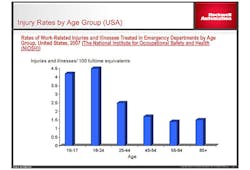SLC 2015: 5 Steps to Overcoming the Baby Boomer Brain Drain
The working population in the U.S. is due for a major shift.
Looking around plants and offices in the country, evidence of this shift should be painfully obvious.
According to research presented by Steve Ludwig—Programs Manager, Safety, at Rockwell Automation—at EHS Today's Safety Leadership Conference last week, the average skilled worker in the U.S. is now 56 years old.
That average is skewed by the overwhelming and lopsided representation of Baby Boomers working in the industry—a population of highly trained and highly skilled worker that accounts for 1/3 of the total workers in the country.
In the next nine years, Ludwig told the EHS Today crowd, over 115 million of those workers will retire. In their wake they will leave the market with a gigantic (and terrifying) skilled worker storage—about 875,000 machinist, welding, and machine operation jobs open when they leave for which there are no trained or qualified workers to take.
Worse, there is only a dim hope of that shortfall being made up with future generations. Along with the pending "brain drain" of the baby boomer crash, Ludwig explained, we're also looking at a steadily declining global population stretching through the foreseeable future.
This is a well-documented and well-covered crisis, however. A flurry of articles about it has been published for the past year--everybody knows it's coming, everybody knows it's going to hurt productivity.
What's often left out of the story, though, is the massive safety risk involved in a whole new generation of untrained workers coming to fill these production holes.
According to Ludwig, millennial workers in particular face a number of challenges entering the workforce.
First, of course, they have the inexperience to deal with. But also, they carry a different mindset into the workplace. They are hesitant to ask questions, they misjudge risks, and too often fail to recognize workplace dangers.
As a result, they are at risk of not only more frequent injuries, but far more acute and serious ones.
To help offset this challenge and safely prepare of the Baby Boomer retirement wave, Ludwig presented a list of five tips that every employer should follow:
1. Community Engagement: Improve the skills and availability of young workers and improve your reputation as an employer.
- Don't assume that schools will produce your workforce.
- Younger people have different skills and experiences than previous generations.
- Engage communities and educational programs to prepare future workers.
- Manufacturing isn't an aspiration for younger workers. Reach out to younger people and underrepresented groups.
2. Rethink Machine Design: Focus on ergonomic, contemporary options.
- Ergonomic design prevents operators and maintenance personnel from strain and repetitive stress.
- Contemporary safety systems (Alternative Protective Measures) prevent injury for younger workers, reduce unscheduled shutdowns and MTTR.
3. Start Training: Improve your workers' skill sets now.
- Establish a formal program to document standard processes and procedures.
- Conduct an analysis of job skills and knowledge levels to ensure your workers have the knowledge and abilities to perform at the desired level.
- Embed a sustainable and flexible competency-improvement program.
4. Augment Core Competencies: Provide supplemental expertise to your skilled workers.
- Determine what skills are only intermittently used.
- Augment core competencies with services. Safety/risk assessments. Occasional maintenance.
- Employ remote monitoring to relieve your workers from mundane activities and help immediately identify and quickly resolve technical issues.
5. Build a Connected Enterprise: Invest in technology to streamline operations, improve productivity and identify risks.
- Reduces job complexity with worker-specific instructions and information.
- Provides convenient mobile information access.
- Reduces travel demands, improves ability of your most knowledgeable, in-demand employees.
- Improves labor utilization.
- Improves safety – provides analysis of safety shutdowns, location, status, etc.


